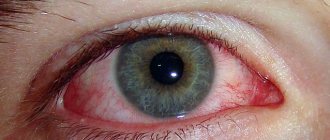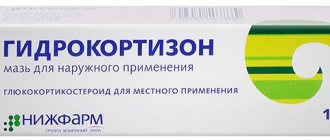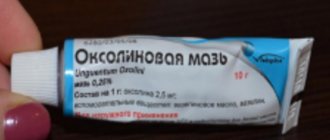For some types of conjunctivitis, not only ophthalmic solutions are used, but also drugs with a longer effect and a high concentration of active ingredients - ointments.
One such remedy is tetracycline ointment , which contains the broad-spectrum antibiotic tetracycline.
It actively suppresses pathogenic bacteria of most types and relieves inflammatory processes.
Conjunctivitis and its symptoms
Conjunctivitis is an inflammatory disease of the conjunctival membrane of the organs of vision .
For your information! The origin of this pathology can vary from traumatic and allergic to viral or fungal.
The conjunctival membrane is always in contact with a large number of foreign bodies, including physical objects, allergens or pathogenic microorganisms.
In addition, such a shell is subject to temperature and climatic influences.
All this can become the main cause or predisposing factor to the development of the disease.
Signs of the disease may vary depending on the form of the pathology, but the main symptoms are:
- redness of the conjunctiva;
- swelling of the upper and lower eyelids;
- itching, irritation and burning in the organs of vision;
- discharge of purulent mucous exudate .
In ophthalmological practice, every third case of a patient's visit to an ophthalmologist relates to conjunctivitis.
This prevalence of pathology is determined by a large number of internal and external predisposing factors and the accessibility of the conjunctiva to external stimuli.
Note! In advanced conditions, this disease can be complicated by perforation of the cornea, keratitis and dry eye syndrome.
In some cases, the course of the pathology is complicated by a temporary severe decrease in visual acuity.
pharmachologic effect
The main active component of the ointment is the antibiotic tetracycline .
At elevated concentrations, which are present specifically in the composition of the drug, such a substance not only fights pathogenic microflora, but also has a bacteriostatic effect .
At the same time, the drug prevents the development of microorganisms in areas treated with the drug.
It should be noted! Tetracycline ointment is active against the following types of microorganisms:
- rickettsia;
- staphylococcus;
- streptococcus;
- mycoplasma;
- gonococcus;
- chlamydia;
- salmonella;
- clostridia;
- Pneumococcus;
- coli;
- shigella
For viral conjunctivitis, this remedy is ineffective . Also, tetracycline has no effect on any type of fungi (in such cases, the use of antifungal drugs is appropriate).
Use for children
The instructions for use of tetracycline ointment contain information that the drug contains an antibiotic. Parents have a completely logical question about the admissibility of using medicine for newborns. The abstract strictly prohibits the use of the drug for children at this age. However, in medical practice there are cases when pediatricians prescribed an individual dosage of tetracycline ointment even to infants. There is a controversial point when a drug containing tetracycline is applied to newborns as a prophylaxis.
The effectiveness of tetracycline ointment for conjunctivitis
Tetracycline first of all prevents the growth and reproduction of pathogenic bacteria , and only then is it a bactericidal drug that destroys such microflora.
Upon contact with microorganisms, tetracycline penetrates their cells, disrupting the processes of their production of protein compounds necessary for life and reproduction.
As a result of such exposure, individual bacteria lose their ability to reproduce and die.
Keep in mind! As part of the ointment, tetracycline has a local effect, without being absorbed deeply into the eye tissue, much less penetrating into the systemic bloodstream.
This results in low toxicity of the drug, a small number of side effects and the possibility of use in the treatment of children.
Precautions and side effects
For some types of conjunctivitis, not only ophthalmic solutions are used, but also drugs with a longer effect and a high concentration of active ingredients - ointments.
One such remedy is tetracycline ointment, which contains the broad-spectrum antibiotic tetracycline.
It actively suppresses pathogenic bacteria of most types and relieves inflammatory processes.
When using eye ointments to treat children, it is very important to take certain precautions. The following must be strictly observed:
- It is necessary to ensure complete cleanliness of hands, both before applying the ointment and after. Failure to maintain hygiene can result in additional infection in the eyes or infecting others. It is recommended to wear gloves before performing this procedure.
The tube of ointment must also be absolutely clean and not come into contact with the infected eye. Otherwise, if pathogenic microorganisms get on the tube spout, the infection will spread further.- Avoid using other people's ointment tubes.
- When treating children with eye ointments, it is extremely important to strictly follow the instructions in the instructions so that an overdose of the medicine does not occur. Some types of ointments have serious side effects.
- You should not try to treat different diseases with the same medications, that is, if the doctor prescribed this or that ointment specifically to treat a given infection, then you should not try to cure other diseases with it on your own.
- Eye ointments should be stored according to the instructions in the instructions.
ATTENTION! Eye medications are stored in the refrigerator or on the balcony during the cold season. - After completing the course of treatment, the remaining ointment should be discarded.
One cannot ignore some of the side effects that may appear after using eye ointments to treat children. Side effects may include:
burning;- the appearance of irritation;
- redness of the eyes;
- allergic reactions of the body (it is better to avoid this situation and check in advance how the body will react to a particular substance contained in the ointment).
Features of treatment
The drug can be prescribed starting from the age of eight , the dosage and frequency of use of the drug will be the same for adults and children .
The medicine, depending on the severity of the symptoms, is placed under the eyelids three to five times a day .
The maximum duration of treatment is one week.
Longer use is possible on the recommendation of a doctor, but often this is an unjustified treatment that can be fraught with negative side effects.
Features of use in a child
Tetracycline ointment is strictly contraindicated for newborns and children under eight years of age , since during this period the active development of bone structures occurs, and tetracycline interferes with these processes and changes bone tissue.
Also, in childhood, the use of the drug can lead to the accumulation of fat cells in the liver (hepatosis).
When using this product, the use of any other topical ophthalmic drugs is not allowed.
In what cases is it used?
It has been noted to be effective in the treatment of childhood conjunctivitis, since the product contains an antibiotic that neutralizes inflammatory processes. Infectious and bacterial ophthalmic diseases are successfully treated with tetracycline eye ointment:
- trachoma (infectious eye disease);
- keratitis (inflammation of the cornea of the eye);
- blepharitis (inflammation of the eyelid).
The ointment can be used to treat various infectious diseases, but before use you need to consult a doctor.
If you decide to treat a small child with tetracycline ointment, you must follow a number of rules:
- the medicine is given no more than 4 times a day;
- before use, wash your hands well with soap;
- After application, the baby will experience discomfort, so parents should distract him so that he does not rub the ointment with his hands.
It is important to look at the expiration date of the drug and make sure it has not expired. The opened tube is stored in a place protected from light at room temperature.
Contraindications
Note! Contraindications to treatment with tetracycline ointment are:
- periods of pregnancy and breastfeeding ;
- intolerance to any components of the ointment;
- liver and kidney diseases affecting the functioning of these organs;
- the presence of ophthalmic fungal diseases .
If you are intolerant or hypersensitive to the components of the product, side effects may occur such as disruption of the gastrointestinal tract, dermatological rashes on the skin around the eyes, redness, itching and burning.
In such cases, the use of the medicine must be stopped and an alternative remedy must be found.
Prevention
To prevent re-infection with conjunctivitis or to avoid catching it the first time, you should be aware of preventive measures.
They are elementary:
- do not touch your eyes unless necessary, do not rub them;
- wash your hands after visiting public places;
- use only your own hygiene products;
- regularly carry out wet cleaning of the house using disinfectants;
- If a foreign body gets into the eye, it should be removed using the tip of an antiseptic wipe or a clean cloth moistened with antimicrobial tissues (Albucid).
To prevent the occurrence of conjunctivitis of any kind, it is necessary to follow the basic rules of hygiene of the eyes, hands and face. It is also not recommended to touch your eyeballs and eyelids with your hands. If there are cases of the disease in the family, you should not share hygiene items, towels and bed linen. Close attention should be paid to children, especially if there are animals in the house.
In public places it is useful to use antiseptics and wet wipes. It is also important to timely treat diseases of the body of various nature and support the immune system.
Reviews
“ conjunctivitis several times throughout my life , and even then in childhood.
But recently, somehow, I again had to go through all the torment associated with my eyes sticking together in the morning and a constant burning sensation.
After studying the offers of modern medicine and consulting with a doctor, I decided to try tetracycline ointment , since the specialist placed special emphasis on the ability to quickly recover with its help.
The product really helped get rid of conjunctivitis in just a week , and despite the fact that the process of putting it on was accompanied by a slight burning sensation, I was pleased with the result.”
Andrey Nikolaev, 36 years old.
“When my daughter developed conjunctivitis last year , the therapist at the clinic advised me to use tetracycline ointment .
I heard that it is better not to use such a remedy to treat a child.
But since my daughter is already ten years old, I decided that if I apply the ointment in smaller dosages and less often than prescribed in the instructions, nothing bad will happen.
The course of treatment with tetracycline in our case lasted five days , and the ointment was used only in the morning and before bedtime. No additional drops or ointments were used for treatment."
Alexandra Soboleva, Novosibirsk.
Doctors' recommendations
For most parents, tetracycline ointment seems to be an effective and safe medicine. The advice of the older generation and the remnants of a scarce past are taking their toll. In the Soviet Union, medications were difficult to obtain, and there was always tetracycline ointment on the shelves, which also cost a penny. It was used by both adults and children with a hint of conjunctivitis or redness in the eyes.
Before starting treatment, you need to consult a pediatrician or ophthalmologist
Grandmothers sincerely believe that if nothing terrible happened then, it won’t happen now. No one is going to dispute the positive results from using the ointment, but you should think about possible complications and allergies. The threat of their development is quite real if the drug is used without a doctor’s prescription.











